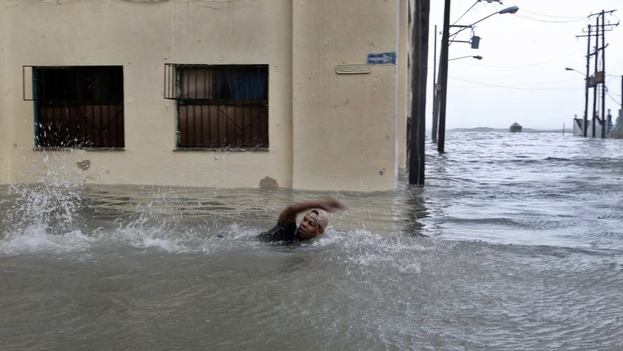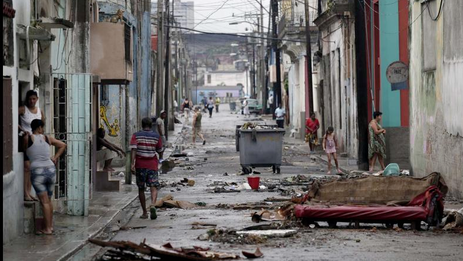
![]() 14ymedio, Zunilda Mata, Havana/Cienfuegos, 12 September 2017 — The air smells of damp and feces. Using a shovel without a handle, Óscar Rodríguez’s family is shoveling the mud out of all the corners of their house on Gervasio Street, a few yards from Havana’s Malecon, an area recently flooded by Hurricane Irma. Everyone is working on the task, the children, the grandmother, and the neighbor who comes over to help.
14ymedio, Zunilda Mata, Havana/Cienfuegos, 12 September 2017 — The air smells of damp and feces. Using a shovel without a handle, Óscar Rodríguez’s family is shoveling the mud out of all the corners of their house on Gervasio Street, a few yards from Havana’s Malecon, an area recently flooded by Hurricane Irma. Everyone is working on the task, the children, the grandmother, and the neighbor who comes over to help.
“I’ve lived in this place since I was born and I’ve never seen anything like it,” says Rodríguez. “We have had floods but they haven’t gone past the door.” This time the sea respected nothing. “We lost two mattresses, the refrigerator got quite wet and the TV fell into the water when we tried to move it to a higher place,” he says.
Rodriguez’s wife circles the water tank in the yard. “We do not have water to drink or to cook because everything is contaminated with the sea and with the contents of the sewage pipes,” he explains. The dog stays put on the stairs leading to the loft platform, guarding it well.
The area where the family lives is supplied by underground electricity, an undeniable advantage for decades for the residents of the San Leopoldo district, which has suffered fewer interruptions than areas are supplied through poles and wires which experience the breaks caused by the winds. But Hurricane Irma has changed the situation.
“They say that electricity will take longer to come back in the underground area because we have to wait for everything down there to dry,” says Rodríguez. They have been without electricity for more than 72 hours and have squeezed every last drop of energy out of everything they had in the house.
“We started with batteries and a flashlight, then we went to candles and now we are getting light from an old kerosene lamp,” he adds. For cooking, the family has a small liquefied gas cylinder that it tries to use as sparingly as possible.
“We had to boil water here for a baby who lives in the next corridor because that family was left with nothing and they have nothing to cook with,” he says.
The hurricane gave the national energy system a real blow. Most of the Cuban thermoelectric plants, with the exception of Renté in Santiago de Cuba and Carlos Manuel de Céspedes in Cienfuegos, are located on the north coast, the strip most damaged by the hurricane in its trajectory on the Island.
The officials of the Electricity Union have clarified that it is not enough to live in an area where the hurricane had fewer direct effects, because the problem is power generation.
The truth of this is evident in Cienfuegos, where, despite being out of the path of Irma, there is not enough energy to restart the thermoelectric plant.
“I do not know what’s worse, the conjunctivitis outbreak or the lack of electricity,” says Olga Lydia Ulloa, a scientist who hopes that the engineers of the power company will manage to restart the city’s power plan and “turn on the light.”
Like most of the island, Cienfuegos has been without electricity for three days. In some places the destruction of the high tension towers and the electricity poles augurs weeks for the recovery.
The director of the Provincial Electricity Office, Ricardo García Parra, told the local press that work is being done intensely with the area’s generators to get the thermoelectric plant working.
“In recent weeks there has been an epidemic of zika and conjunctivitis in the village and, to top it off, the hurricane has left us with no lights; we have little kids and nothing to cook with,” says Ulloa.
Most Cubans were forced to use electricity as their only cooking option after the “energy revolution” promoted by the late President Fidel Castro. Although the unrationed sale of liquefied gas to households has been allowed in recent years, the price is high for an average worker, which limits access.
Private markets also have electric service thanks to generators that work with fuel oil and diesel, but only two provincial hospitals in the territory and its surrounding areas had electricity as of Tuesday.
Despite the disaster, in Havana there is room for hope. The Máximo Gómez Thermoelectric Power Plant of Mariel, one of those affected, was ready to begin service on Monday, after intense hours of repairs and hundreds of thousands of residents in Havana are hopeful that this energy colossus will bring them out of the dark .
The tracks left by “the days of the water”
But now, “the worst is the smell, there is no one who can stand it,” says Óscar Rodríguez as he removes pieces of wood, paper and some crushed beer cans from the mud. “At first it smelled of the sea, but as the waters receded this plague has come and now even we smell like this,” he laments.

No one has showered since last Friday. They all try to drink little water so they do not use up the “strategic reserves,” as Grandma calls them, and continue look for some belongings, such as shoes and an identity card that seem to have gone with the flow.
Outside, some kids are enthusiastic about the day they swam down Gervasio Street, the dips in Maceo Park and how the wall of the Malecon disappeared after being covered by the sea. They have not had classes this Monday and nobody knows when they will reopen the schools in the area. At the moment the priorities seem to be different.
The epidemiological situation has been deteriorating since the floods began. The area, one of the most densely populated in the whole of the country, has a great number of buildings where dozens of families live in crowded conditions. Now, most of those residents are stationed outside their homes because the heat and bad smell make it unbearable to stay inside.
Others do not want to be in their homes for fear that the old walls will end up collapsing when they dry. “This is on the verge of pure miracle,” a resident of a tenement at San Lázaro and Lealtad streets tells this newspaper. The narrow, winding hallway is still wet. The rooms on either side have their doors open and waterlogged belonging are set out everywhere under the sun to dry.
The image is like a ship with ragged sails and tired-eyed sailors on no fixed course. The neighborhood of San Leopoldo continues to experience its own shipwreck a few hours after the waters recede.
